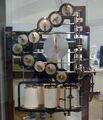Template:Selected anniversaries/March 22: Difference between revisions
No edit summary |
No edit summary |
||
| Line 26: | Line 26: | ||
File:Thomson_tide_calculator.jpg|link=Tide-predicting machine (nonfiction)|1869: Aquatic cryptid and alleged supervillain [[Neptune Slaughter]] steals [[Tide-predicting machine (nonfiction)|Thomson tide calculator]] for personal use; Steampunks outraged. | File:Thomson_tide_calculator.jpg|link=Tide-predicting machine (nonfiction)|1869: Aquatic cryptid and alleged supervillain [[Neptune Slaughter]] steals [[Tide-predicting machine (nonfiction)|Thomson tide calculator]] for personal use; Steampunks outraged. | ||
||1903 | ||1903: Bill Holman born ... cartoonist. | ||
File:Nathan Rosen.jpg|link=Nathan Rosen (nonfiction)|1909: Physicist [[Nathan Rosen (nonfiction)|Nathan Rosen]] born. He will develop the idea of the Einstein–Rosen bridge, later named the wormhole. | File:Nathan Rosen.jpg|link=Nathan Rosen (nonfiction)|1909: Physicist [[Nathan Rosen (nonfiction)|Nathan Rosen]] born. He will develop the idea of the Einstein–Rosen bridge, later named the wormhole. | ||
||1909 | ||1909: Gabrielle Roy born ... engineer (?) and author ... There is a quotation by her on the back of the Canadian $20 bill that reads: "Could we ever know each other in the slightest without the arts?" | ||
|File:Tempest prognosticator.jpg|link=Tempest prognosticator (nonfiction)|1910: [[Tempest prognosticator (nonfiction)|Tempest prognosticator]] used to predict and prevent [[crimes against mathematical constants]]. | |File:Tempest prognosticator.jpg|link=Tempest prognosticator (nonfiction)|1910: [[Tempest prognosticator (nonfiction)|Tempest prognosticator]] used to predict and prevent [[crimes against mathematical constants]]. | ||
||1913 | ||1913: Ruggero Oddi dies ... physiologist and anatomist. | ||
||Irving Kaplansky | ||1917: Irving Kaplansky born ... was a mathematician, college professor, author, and musician. Pic. | ||
||Carson Dunning Jeffries | ||1922: Carson Dunning Jeffries born ... physicist. The National Academies Press said that Jeffries "made major fundamental contributions to knowledge of nuclear magnetism, electronic spin relaxation, dynamic nuclear polarization, electron-hole droplets, nonlinear dynamics and chaos, and high-temperature superconductors." He was noted for being the first to observe the isotropic spin-spin exchange interaction in metals (also known as the Ruderman-Kittel interaction). He also discovered methods for the dynamic nuclear polarization by saturation of forbidden microwave resonance transitions in solids. He also discovered the existence of giant electron-hole droplets in semiconductors. | ||
||1924: William Macewen dies ... surgeon and neuroscientist. | ||1924: William Macewen dies ... surgeon and neuroscientist. | ||
| Line 58: | Line 58: | ||
||1953: Gustav Herglotz dies ... mathematician. He is best known for his works on the theory of relativity and seismology. | ||1953: Gustav Herglotz dies ... mathematician. He is best known for his works on the theory of relativity and seismology. | ||
||1960 | ||1960: Arthur Leonard Schawlow and Charles Hard Townes receive the first patent for a laser. | ||
||1975 | ||1975: A fire at the Browns Ferry Nuclear Power Plant in Decatur, Alabama causes a dangerous reduction in cooling water levels. | ||
||Hans Thirring | ||1976: Hans Thirring dies ... theoretical physicist, professor, and father of the physicist Walter Thirring. He won the Haitinger Prize of the Austrian Academy of Sciences in 1920. Together with the mathematician Josef Lense, he is known for the prediction of the Lense–Thirring frame dragging effect of general relativity in 1918. | ||
||1978 | ||1978: Karl Wallenda dies ... acrobat and tightrope walker, founded The Flying Wallendas. | ||
||Raymond Thayer Birge | ||1980: Raymond Thayer Birge dies ... physicist. | ||
||1982: NASA's Space Shuttle Columbia is launched from the Kennedy Space Center on its third mission, STS-3. | ||1982: NASA's Space Shuttle Columbia is launched from the Kennedy Space Center on its third mission, STS-3. | ||
| Line 88: | Line 88: | ||
||2011: Philippe Flajolet dies ... computer scientist. He will contribute to general methods for analyzing the computational complexity of algorithms, including the theory of average-case complexity. Pic. | ||2011: Philippe Flajolet dies ... computer scientist. He will contribute to general methods for analyzing the computational complexity of algorithms, including the theory of average-case complexity. Pic. | ||
||2012: David Waltz dies ... computer scientist and | ||2012: David Waltz dies ... computer scientist and academic. | ||
</gallery> | </gallery> | ||
Revision as of 11:25, 8 October 2018
1868: Physicist Robert Andrews Millikan born. He will win the Nobel Prize for Physics in 1923 for the measurement of the elementary electronic charge and for his work on the photoelectric effect.
1869: Aquatic cryptid and alleged supervillain Neptune Slaughter steals Thomson tide calculator for personal use; Steampunks outraged.
1909: Physicist Nathan Rosen born. He will develop the idea of the Einstein–Rosen bridge, later named the wormhole.
1929: Art critic and alleged supervillain The Eel attends birthday party for Nathan Rosen. They will later collaborate on ideas which will lead The Eel to construct a portable wormhole generator.
1948: Computer programmer and crime-fighter Jean Bartik uses the ENIAC computer to detect and prevent crimes against mathematical constants.
1990: Engineer Gerald Bull assassinated. He attempted to build artillery guns which could launch satellites into orbit.
2001: Capacitor plague affects several brands of portable envy devices.
2002: Portable envy components at risk of capacitor plague.







